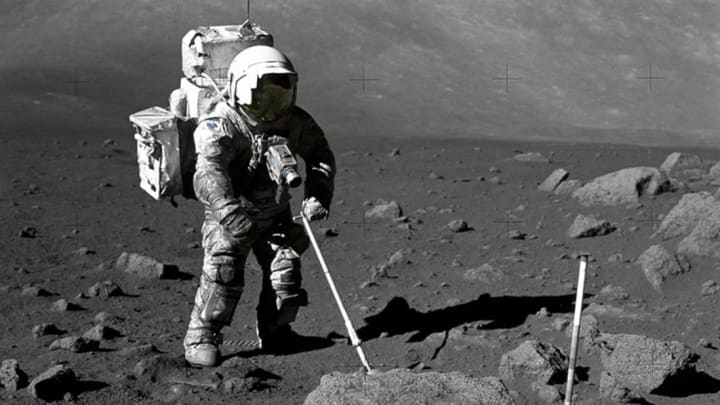Look Up Tonight! It's International Celebrate the Moon Night

Here is what you need to do to celebrate International Observe the Moon Night: 1. Go outside tonight; 2. Look up; 3. Find the large white crescent in the sky; 4. Observe it. (Oohing and aahing are optional but recommended.)
Having done those things, you might find it hard not to reflect on what the Moon has meant to humanity, that 12 Americans have actually walked around up there—and that in the coming years, some people might call it home.
The event is sponsored by a swath of the planetary science community, including the Lunar and Planetary Institute and NASA’s Lunar Reconnaissance Orbiter team. The celestial celebration's goal is to encourage "observation, appreciation, and understanding of our Moon and its connection to NASA planetary science and exploration."
It comes seven months after the White House proposed to cut $76 million from last year's appropriation to the NASA Planetary Science Division, in a budget request that defunds the Lunar Reconnaissance Orbiter entirely.
International Observe the Moon Night has spawned viewing parties to be held around the world—find your nearest celebrating observatory or astronomy society here—where planetary scientists and astronomers will have telescopes aimed and give talks on some of the surprising processes at work on the lunar surface.
As you gaze upon the Moon, consider how it influences the tides and might power cities of the future, and that our visits there remain the defining achievement of human engineering and exploration. Our taken-for-granted celestial wonder deserves a few minutes of our time this weekend.
But before you look up, let's review some Moon missions and essential facts.
THE LUNAR RECONNAISSANCE ORBITER
On June 23, 2009, the Lunar Reconnaissance Orbiter (LRO) entered orbit around the Moon and has since transformed our understanding of the lunar surface. We now know more about the Moon than ever before, and understand to an unprecedented degree that the lunar surface is a highly dynamic place. Since LRO mapping began, planetary scientists have recorded more than 10,000 surface changes. (There are even landslides on the Moon.) The spacecraft is prodigious in its output, having produced more data than every other planetary science mission combined.
This includes high-resolution imaging the far side of the Moon—not the "dark" side of the Moon, because it's actually lit by the sun every two weeks.
The far side was first imaged by the Soviet spacecraft Luna 3 in 1959. Six years later, the Soviet Zond 3 spacecraft returned even better images. But the LRO has mapped every inch of the Moon in such mind-blowing detail that footsteps by the Apollo astronauts can be discerned, and at least one image produced of its north pole is 3.3 terabytes large. If printed, the image would cover an area larger than a football field.
APOLLO SAMPLES AND A POWER SOURCE
Close study of the Moon matters in part because of its natural resources, the most notable being helium-3 in the Moon’s regolith. (That's the loose stuff in which Apollo astronaut boot prints are pressed, though the regolith goes much deeper than that.) On Earth, which is protected by a magnetosphere, Helium-3 is rare—but the surface of the Moon, which has no magnetosphere and thus has been bombarded by solar wind for billions of years, is rich with the isotope.
Helium-3 is a perfect fuel for fusion reactors because it's not radioactive and will not produce the nasty byproducts of other reactor fuels. This is a good example of how NASA's planetary science missions can directly benefit life on Earth. For humanity's purposes, the Moon is to fusion reactors what Texas is to oil refineries, and we might well be a generation or two away from having the planet's energy needs solved.
With respect to lunar science, samples collected from the Apollo mission continue to pay dividends to those who study them. As new techniques and modern instruments are applied to the Moon rocks, the history of the Moon is being rewritten. Similarly, scientists have revisited data collected by a seismometer brought to the Moon by Apollo 16 astronauts. After applying new algorithms to the 40-year-old data, they discovered 210 previously unknown moonquakes.
A HUB OF RESEARCH ACTIVITY
Today, the Moon is a busy place. In addition to the busy Lunar Reconnaissance Orbiter, the NASA ARTEMIS spacecraft is out there studying the effects of solar wind on the Moon. The China National Space Agency Chang’e 5-T1 service module is in lunar orbit, mapping landing sites for the 2017 Chang’e 5 sample return mission. The Chang’e 3 lander, meanwhile, and its rover, Yutu, are still in operation, returning instrument data, including that from a ground penetrating radar.
And the Moon might get busier still. The new head of the European Space Agency is a vocal proponent of a manned lunar base to replace the aging International Space Station. Scientists have studied such a concept for a very long time, he said in April, "but now we have to do it as opposed to study it." Specifically, he would like a colony on the far side of the Moon, where a radio telescope might also be installed. The concept appeals to astronomers, according to New Scientist, as such a telescope could probe the universe for radio signals that harken back to a time even before the formation of stars and galaxies—a scant hundreds of millions of years after the Big Bang. We can’t really do this from Earth because of the ionosphere and FM radio signals. The far side of the Moon, however, is quiet and ideal for such work.
Until such a time as China completes a crewed lunar mission or ESA builds a base there, the Apollo astronauts will remain the only humans to have traveled beyond low-Earth orbit, which reaches out approximately 1200 miles. The International Space Station orbits the Earth at 250 miles above the planet’s surface; the Moon, meanwhile, is 238,900 miles away.